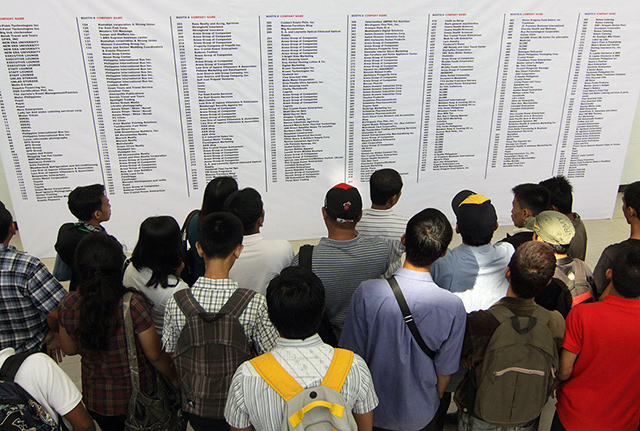Filtered By: Money
Money
PHL unemployment: A problem runs deep
By SIEGFRID O. ALEGADO, GMA News

Job seekers flock to the SMS Mall of Asia in Pasay City on Friday for the Unlad Kabuhayn Job Fair. While optimism abounds over prospects of a Philippines joining the ranks of Asian tiger economies, critics caution that an elite but dominat class has long dominated the social strata, amassing most of the new wealth being created while the poor misses the opportunity to make money. Photo by Danny Pata
There is a pressing need for a road map towards improving the lag in agriculture and manufacturing to address a stubbornly high unemployment rate.
Analysts interviewed by GMA News Online said a strong output alone – which grew by 7.4 percent in the first three quarters of 2013, the fastest phase in Southeast Asia – cannot address Philippine unemployment, especailly by relying heavily on the services sector.
The United Nations (UN) and the International Monetary Fund (IMF) have this to say about the Philippine economy: it will continue growing faster than peer economies in Southeast Asia.
Despite the rosy predictions, and the latest performance of the economy, the Philippines has the highest unemployment rate in the region.
“Translating economic growth into employment opportunities remains a significant challenge in the Philippines,” according to the UN World Economic Situation and Prospects 2014 report released earlier this week.
The National Statistics Office (NSO) has noted the population of working age Filipinos or those over 15 years old are more than 63.1 million. But employment in the services sector’s sunshine industry –business process outsourcing – account for less than a million jobs.
Not enough
Not enough
Jobs are being generated, but not fast enough to make a dent in unemployment rate of 6.5 percent as of end-October 2013, said Emilio Neri Jr., Bank of the Philippine Islands lead economist.
“Jobs growth is commendable, but it is not enough,” he said.
The latest unemployment number actually dipped from 6.8 percent in October 2012, but a labor expert said this could be because more Filipinos have given up looking for jobs.
Rene Ofreneo, professor at the University of the Philippines School of Labor and Industrial Relations (UP SOLAIR), noted the NSO definition of labor force refer to Filipinos 15 years old and above, employed or unemployed but actively looking for jobs.
“A lot of people gave up looking for jobs,” he said.
Workers in the services sector comprised the largest proportion of those who are employed or 53.4 percent of the total in October 2013, according to the NSO.
But Ofreneo said much of the employment in the services sector consists largely of home-based work, or low-productivity jobs in microenterprises, and contractual work in the retail industry.
Because of this reality, the absence of structural reforms will keep the unemployment rate swinging within 6 to 7 percent.
“We have very weak jobs generation, especially good quality jobs which is obtained by an economy growing on its industrial feet,” the UP SOLAIR professor said. “Government should do bolder reforms.”
Quality employment refers to jobs that espouse security of tenure and mandated benefits like health insurance and social security.
Playing catch up
Playing catch up
However, strengthening the agriculture and industrial sectors is not a walk in the park.
This entails playing catch up in infrastructure development, which has been neglected for decades, said Ildemarc Bautista, Metropolitan Bank & Trust Co. (Metrobank) research head.
Addressing the infrastructure gap, which the World Economic Forum identified as a debilitating bottleneck that chokes investments, will help grow manufacturing and agriculture by easing the hurdles in the supply chain.
The whole point mainly revolves on the “investment climate... improving the cost of doing business... infrastructure and logistics,” IMF resident representative Shanaka Jayanath Peiris told reporters in a briefing on Wednesday.
“There are also other things that are important. A large part of the population is in agriculture, and it's not only about manufacturing. Farm-to-market roads are also very important,” he added.
Metrobank's Bautista envisions a more synergistic approach to things, saying government may link manufacturing with agriculture as a means to creating quality employment.
“Agro-industries, agribusinesses – there are a lot of opportunities in that area,” he said.
'Growth drivers'
'Growth drivers'
Socioeconomic Planning Secretary Arsenio Balisacan said the government is aware of areas its needs to improve.
“I’m also more concerned about the quality of employment,” said Balisacan, who is also director general at National Economic and Development Authority.
“That’s why we're pushing for growth drivers like manufacturing, tourism, agribusiness, and infrastructure. Those are the ones that can potentially generate these kinds of high quality employment,” he noted.
Balisacan said government is working on an update to the Aquino administration’s Philippine Development Plan 2011-2016, which focuses on creating jobs at the grassroots level and addressing poverty.
In updating the plan, economic managers have consulted regional stakeholders to ensure that economic initiatives will be felt at the grassroots level.
But three years after the current administration took over the helm of government in 2010, UP SOLAIR professor Ofreneo sensed the urgency of the situation.
“They really have to come out with a clear plan soon,” Ofreneo said. – VS, GMA News
More Videos
Most Popular




